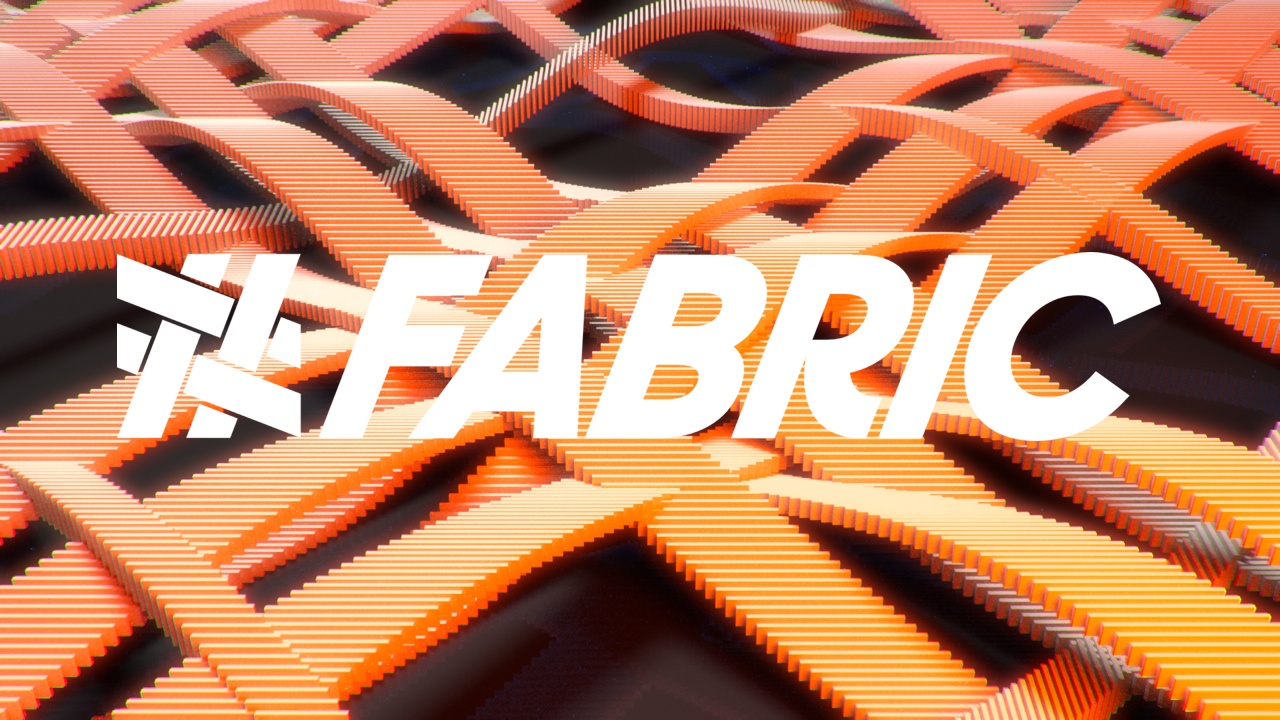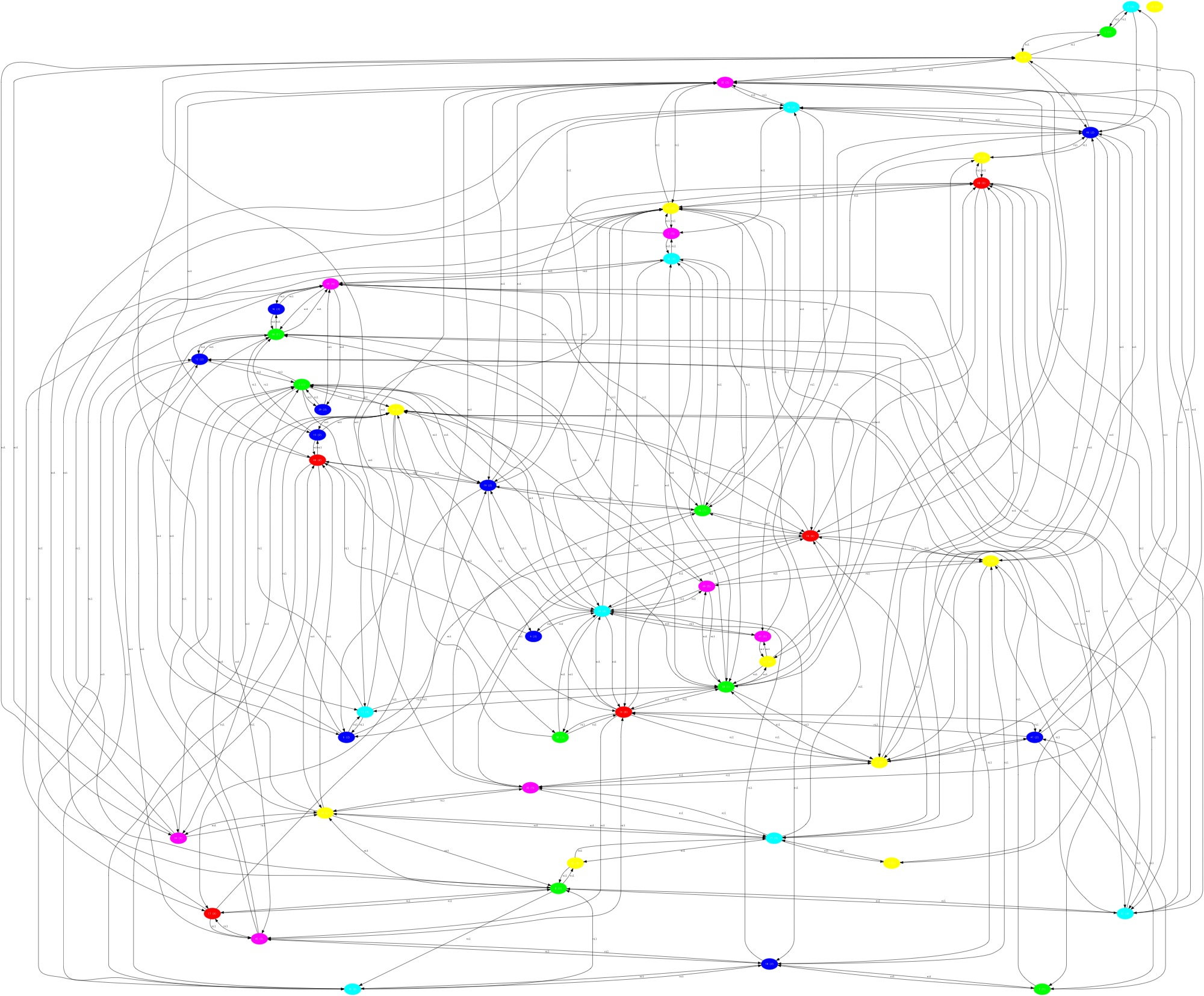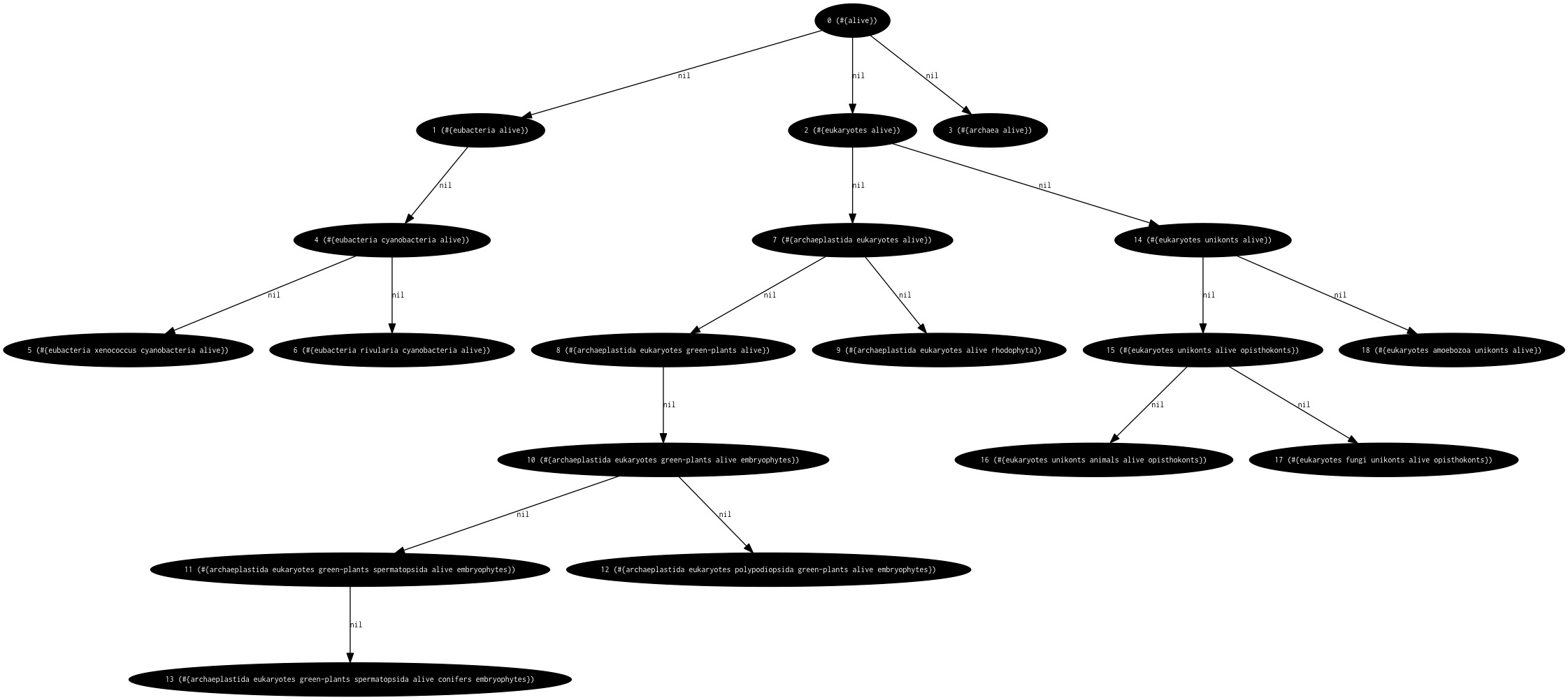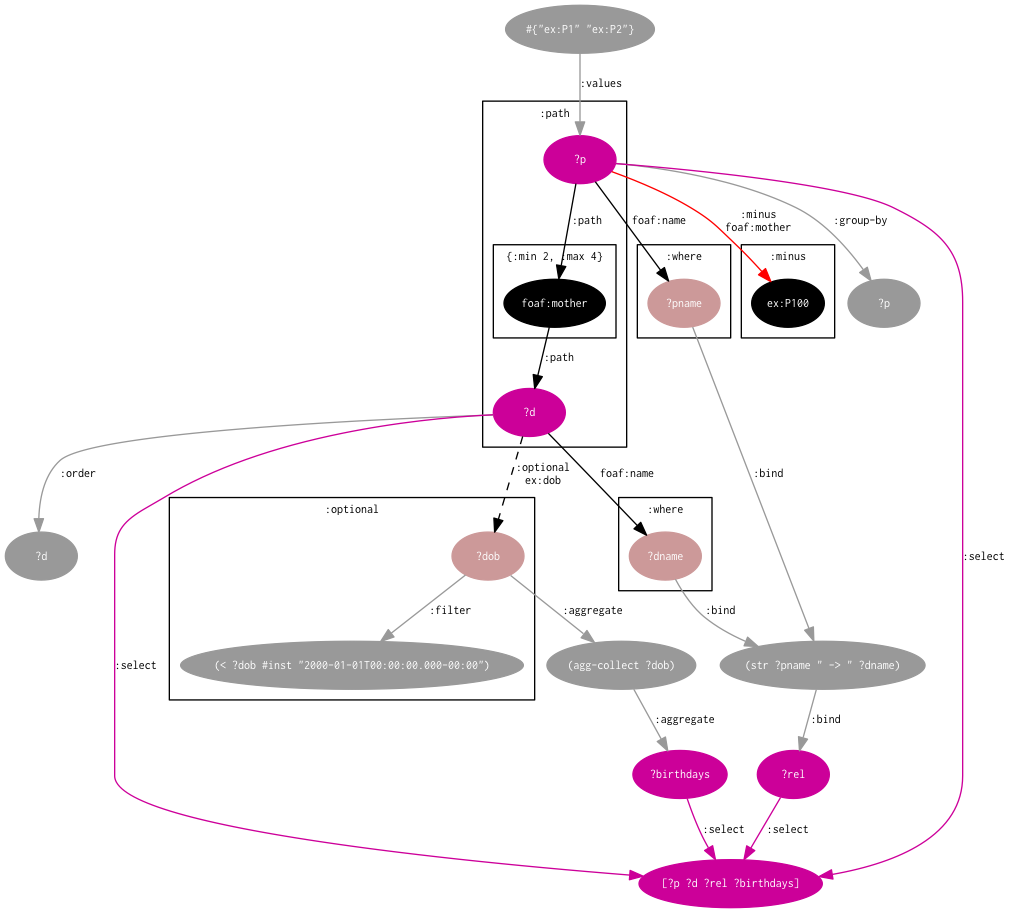Modular, Signal/Collect inspired compute graph infrastructure for Clojure & Clojurescript. Written in a Literate Programming format.
- About the project
- Project definition
[thi.ng/fabric "0.0.388"]These libraries are built around the model of a directed, potentially cyclic graph structure, in which vertices hold state and edges are functions sending possibly transformed states to other vertices in the graph. All processing is done in two phases, both of which are score guided and completely customizable:
- Signaling: The operations carried out by edge functions, each accepting their source vertex’ state value, transforming it and placing it in a signal map/queue of their target vertex. Vertices only signal if the user defined (or default) scoring function exceeds a threshold (user defined as well).
- Collecting: Each vertex can define its own collection function, responsible for processing any uncollected signal values and producing a new state value. As with signaling, vertices only collect if their collection score exceeds a threshold value. This allows users to implement different collection behaviors (e.g. semi-lazy or batched or only after certain amount of uncollected signals have been received etc.)
There’re many different ways to execute these two operational phases (e.g. ordered vs. unordered, interleaved, thresholded, eager, async etc.) and the core library provides 3 different execution contexts (also fully configurable) to tailor the execution model for different use cases. For some problem domains choosing one model over another can provide major (500-1000%) speedups (e.g. see Vertex coloring example below).
Common to all supplied execution models/contexts is the notion of graph convergence (a term borrowed from the original Signal/Collect papers, link below). Since both signal and collect operations are score guided, the executors can keep track of the remaining active work set. A graph is called converged if there’re no more vertices left which should emit signals or can collect. Due to the model explicitly allowing cycles (recursion) in the graph, users can also specify halt thresholds to forcefully terminate graph execution when a certain number of operations has been carried out, but then potentially leaving the graph in a non-converged state (which in some use cases is a valid result).
The Signal/Collect model provides both a flexible and elegant metaphor for many problem domains. To avoid a monolithic one-fits-all approach and provide somewhat of a thematic focus, this project is structured into different modules (all described & linked below).
- Modular architecture (see Modules section below)
- Easy-to-use API, each module exposes both high & low-level functionality
- Protocol based implementation for extensibility
- Literate programming format w/ extensive docs, diagrams & examples
- Over 150 tests
- Customizable vertex, edge, graph & execution context types
- 3 types of graph execution contexts built-in
- Sync, async, parallel & continuous processing (and mixtures of)
- Partial or stepwise execution
- Activity scoring system (customizable)
- Automatic graph convergence detection (no more outstanding actions)
- Computation of minimum active work set
- Built-in graphs & vertices are mutable (via atoms)
- Edges are functions and all signal/collect actions are purely functional too
- Support for graph modification logging (persistence, event sourcing etc.)
- Self-modifiable graphs during execution (add/remove/modify vertices/edges)
- Semantic knowledge graph (triple or quad based)
- Fully featured, efficient query engine using query trees
- Graph pattern matching w/ variables
- Sub-queries (joins, optional joins, unions, negation)
- Filters / pre-filters
- Grouping (based on vars or expressions)
- Computed vars result injection
- Aggregation
- Bounded length (variable) path queries (with min/max limits)
- Pervasive re-use of intermediate results
- Optional map based query & expression DSL (EDN serializable)
- Query & rule based fact inferencing (additions & retractions)
- Fact conversion/transformation/indexing
- Conversion of nested Clojure map to triples
- N-Triples parser w/ extensible object literal conversions
- Linked Data server components & ready-to-go default setup (using Stuart Sierra’s component lib)
- HTTP API to manipulate & query fact graphs
- EDN/N-Triples facts import via URIs (w/ 303 redirect handling)
- Async request handlers & graph processing (default config uses Aleph server)
- Registered queries/rules w/ auto-updating results
- OWL-RL inference rules (sub-set)
- Multiple response formats (EDN, JSON, JSON-LD, SPARQL JSON, CSV)
See the README of modules below for full feature sets…
- fabric-core - Core compute graph functionality
- fabric-facts - Semantic knowledge graph, query DSL, cached query trees, inferencing, I/O, parsing
- fabric-ld - Component based Linked Data HTTP server & query endpoint setup (WIP)
- fabric-redis - Redis backend (WIP, not yet included)
ALPHA quality, in active development.
Currently, the included test cases and examples for each module act as the best demonstration of usage patterns and also show most of the currently implemented functionality:
Calculate minimum distance from a single node to all others (connected) in the graph. Also see benchmarks.
Only these two custom signal & collect functions are needed (in addition to setting up the graph):
(defn signal-sssp
[vertex dist] (if-let [v @vertex] (+ dist v)))
(def collect-sssp
(f/collect-pure
(fn [val uncollected]
(if val (reduce min val uncollected) (reduce min uncollected)))))(Click image to view bigger version to see edge weights/distances)
Assign each vertex a color from a limited pallette such that no two neighbors have the same color. This is one of the examples used for the above benchmarks. Please note the drastic performance difference between different execution models (synchronous vs. eager). If the number of possible colors is reduced further, the synchronous approach will not converge at all.
Given a graph encoding a tree structure (e.g. type hierarchy), compute all super types for each node. This example uses a tiny fragment of top-level classes of phylogenetic Tree Of Life.
Apart from adding the data to the graph, the only user code required to collect the closure(s) is this custom collection function used for each vertex:
(def collect-transitive-closure
(f/collect-pure
(fn [val uncollected]
(reduce into val uncollected))))The fabric-facts module provides a map based DSL to specify fact queries based on graph pattern matching (similar to SPARQL). The module also provides a visualizer to help document & debug complex queries. E.g. the following query can be visualized (using Graphviz) like this:
;; 1) match transitive mother relationships (w/ depth 2-4)
;; 2) exclude rels to descendant "ex:P100"
;; 3) match names for entities
;; 4) optionally match descendant's DOB (only if before given date)
;; 5) collected all DOBs into new result var
;; 6) inject new result var ?res using string formatting
;; 7) pre-bind/restrict possible values for ?p
;; 8) order, group and select vars
(->> '{:q [{:path [?p ["foaf:mother"] ?d] :min 2 :max 4}
{:minus [[?p "foaf:mother" "ex:P100"]]}
{:where [[?p "foaf:name" ?pname]]}
{:where [[?d "foaf:name" ?dname]]}
{:optional [[?d "ex:dob" ?dob]]
:filter (< ?dob #inst "2000-01-01")}]
:aggregate {?birthdays (agg-collect ?dob)}
:bind {?rel (str ?pname " -> " ?dname)}
:values {?p #{"ex:P1" "ex:P2"}}
:group-by ?p
:order ?d
:select [?p ?d ?rel ?birthdays]}
(query->graphviz)
(spit "qviz-ex01.dot"))Excerpt of an example interaction with a fabric-ld server from the command line (e.g. using httpie instead of curl for brevity):
# import facts from URI (currently EDN or N-Triples only)
http -f POST :8000/facts uri=http://schema.org/version/2.0/schema.nt
# {:body "adding 9023 facts from http://schema.org/version/2.0/schema.nt"}
# add facts in EDN format about this project
# EDN maps offser a concise way to declare multiple relationships for
# for a common subject and are automatically resolved to triples
# facts can also be given as EDN triple vectors
http -f POST :8000/facts \
facts='{"http://thi.ng/fabric" \
{"rdf:type" "foaf:Project" \
"schema:isPartOf" "http://thi.ng" \
"dcterms:creator" "people:toxi"}}'
# {:body "adding 3 facts"}
# register query: find all projects and all their facts, group by project
http -f POST :8000/queries \
id=projects \
q='{:q [{:where [[?prj "rdf:type" "foaf:Project"] [?prj ?p ?o]]}] \
:order ?p \
:group-by ?prj \
:select [?p ?o]}'
# {:id "projects", :body "New query registered"}
# get query results
http :8000/queries/projects
# {:id "projects2", :count 1, :total 1, :offset 0,
# :spec {:q [{:where [[?prj "rdf:type" "foaf:Project"] [?prj ?p ?o]]}],
# :order ?p,
# :group-by ?prj,
# :select [?p ?o]},
# :body {"http://thi.ng/fabric"
# [{?p "http://purl.org/dc/terms/creator", ?o "people:toxi"}
# {?p "http://schema.org/isPartOf", ?o "http://thi.ng"}
# {?p "http://www.w3.org/1999/02/22-rdf-syntax-ns#type", ?o "http://xmlns.com/foaf/0.1/Project"}]}}Note: This example is somewhat out of date in that it hardly uses the more user-friendly and powerful query DSL and instead largely defines queries via low-level forms. For a better overview please consult the thi.ng.fabric.facts.dsl namespace in the facts module, as well as the fabric-ld module.
This example (and module) uses a compute graph to store facts, fact queries and inference rules (based on queries) to create new facts. Queries and inference rules are expressed as vertex trees, taking part in the normal graph execution. This example demonstrates how easy it is to use this architecture to build custom rule engines or use with Linked Data applications (the query engine features are heavily inspired by W3C SPARQL, albeit using Clojure syntax and no RDF restrictions). Whenever facts are added or removed from the graph (either manually or via inference), all query results are updated (somewhat equivalent to stored procedures in SQL). In complex queries, intermediate query vertices act as result cache and potentially limit/avoid work to do.
(require '[thi.ng.fabric.core :as f])
(require '[thi.ng.fabric.facts.core :as ff])
(require '[thi.ng.fabric.facts.dsl :as dsl])
;; turn off verbose logging
#?(:clj (taoensso.timbre/set-level! :warn))
;; Initial facts
(def facts
'[[toxi author fabric]
[toxi parent noah]
[ingo parent toxi]
[fabric type project]
[fabric url "http://thi.ng/fabric"]
[author domain person]
[author range creative-work]
[parent sub-prop-of ancestor]
[ancestor type transitive-prop]
[ancestor domain person]
[ancestor range person]])
;; Rule specs (all join queries) and their production functions
;; The production fns take 3 args: the graph, the inference vertex
;; (for context, though here unused) and a single query result
;; from which a new fact is inferred...
(def inference-rules
{;; infer type of subject for any property which declares a domain
:domain {:match '[[?a ?prop nil] [?prop domain ?d]]
:infer (fn [g _ {:syms [?a ?prop ?d]}] (ff/add-fact! g [?a 'type ?d]))}
;; infer type of object for any property which declared a range
:range {:match '[[nil ?prop ?a] [?prop range ?r]]
:infer (fn [g _ {:syms [?a ?prop ?r]}] (ff/add-fact! g [?a 'type ?r]))}
;; infer transitive property relationships
;; e.g. ?a ancestor ?b and ?b ancestor ?c => ?a ancestor ?c
:transitive {:match '[[?a ?prop ?b] [?b ?prop ?c] [?prop type transitive-prop]]
:infer (fn [g _ {:syms [?a ?prop ?c]}] (ff/add-fact! g [?a ?prop ?c]))}
;; infer super property relationships from sub-properties
;; e.g. parent is a specialization/sub-prop of ancestor
:sub-prop {:match '[[?a ?prop ?b] [?prop sub-prop-of ?super]]
:infer (fn [g _ {:syms [?a ?super ?b]}] (ff/add-fact! g [?a ?super ?b]))}})
;; Create empty knowledge graph using default compute graph as backend
(def g (ff/fact-graph))
;; Setup execution context (with default opts)
(def ctx (f/sync-execution-context {:graph g}))
;; Define a query returning *all* facts (nil catches any subject, pred, object)
(def all (ff/add-query! g [nil nil nil] {}))
;; Add facts & rules to graph
(run! #(ff/add-fact! g %) facts)
(run!
(fn [[id r]] (ff/add-rule! g {:id id :patterns (:match r) :production (:infer r)}))
inference-rules)
;; Execute!
(f/execute! ctx)
;; The `all` var (defined above) is closing over all its related vertices.
;; Its query result can obtained by dereferencing...
(prn (sort @all))
;; ([ancestor domain person]
;; [ancestor range person]
;; [ancestor type transitive-prop]
;; [author domain person]
;; [author range creative-work]
;; [fabric type creative-work] ;; inferred
;; [fabric type project]
;; [fabric url "http://thi.ng/fabric"]
;; [ingo ancestor noah] ;; inferred
;; [ingo ancestor toxi] ;; inferred
;; [ingo parent toxi]
;; [ingo type person] ;; inferred
;; [noah type person] ;; inferred
;; [parent sub-prop-of ancestor]
;; [toxi ancestor noah] ;; inferred
;; [toxi author fabric]
;; [toxi parent noah]
;; [toxi type person]) ;; inferred
;; Add another query, this time with a variable binding (?p)
(def people (ff/add-param-query! g '[?p type person] {}))
(f/execute! ctx)
(prn @people)
;; #{{?p toxi} {?p noah} {?p ingo}}
;; complex queries can be more easily defined via query specs:
;; here, a filtered join query (reusing above people query) to only select
;; people with age < 20 and inject a new result var ?num (aggregated result count)
(def children
(dsl/add-query-from-spec!
g '{:q [{:where [[?p age ?age] [?p type person]]
:filter (< ?age 20)}]
:aggregate {?num (agg-count)}}))
(ff/add-fact! g '[noah age 13])
(ff/add-fact! g '[toxi age 40])
(f/execute! ctx)
(prn @children)
;; #{{?p noah ?age 13 ?num 1}}
;; join queries can also be constructed directly:
;; a query returning all creative-works w/ their authors & urls
(def projects
(ff/add-query-join!
g '[[?prj type creative-work] [?prj url ?uri] [?auth author ?prj]] {}))
(f/execute! ctx)
(prn @projects)
;; #{{?prj fabric, ?uri "http://thi.ng/fabric", ?auth toxi}}(require '[thi.ng.fabric.core :as f])
(require '[clojure.core.async :refer [go-loop <! chan]])
(def g (f/compute-graph))
(def result-chan (chan))
(def ctx (f/async-execution-context {:graph g :result result-chan}))
;; Define vertex collection functions
(defn collect-with
[f] (fn [v] (f/set-value! v (reduce f (vals (f/signal-map v))))))
(def collect-sum (collect-with +))
(def collect-product (collect-with *))
;; Define some data vertices with values to sum
(def A1 (f/add-vertex! g 100.00 {}))
(def A2 (f/add-vertex! g 200.00 {}))
(def A3 (f/add-vertex! g 300.00 {}))
;; Another one with VAT rate
(def VAT (f/add-vertex! g 1.2 {}))
;; This vertex will produce the net price (the sum of A1 + A2 + A3, see below...)
(def NET (f/add-vertex! g nil {::f/collect-fn collect-sum}))
;; And this one the total (net * vat)
(def TOTAL (f/add-vertex! g nil {::f/collect-fn collect-product}))
;; Connect everything together:
;; The direction is always src -> dest
;; signal-forward will simply send a vertex' value as signal
;; The nil arg is because signal-foward doesn't use any signal arguments
;; but other signal functions could make use of this extra arg (see SSSP example above)
(run! (fn [[a b]] (f/connect-to! a b f/signal-forward nil))
[[A1 NET] [A2 NET] [A3 NET] [NET TOTAL] [VAT TOTAL]])
;; Everytime the graph converges into a stable/unchanging state
;; the async execution context will pause & push a result map to the channel provided
;; Here we simply print it out along with the values of the NET & TOTAL vertices
(go-loop []
(when-let [res (<! result-chan)]
(prn :result res)
(prn :net @NET)
(prn :total @TOTAL)
(recur)))
;; Kick off computation
(f/execute! ctx)
;; :result {:collections 3, :signals 5, :type :converged, :runtime 1.9211129999999998, :time-per-op 0.24013912499999998}
;; :net 600.0
;; :total 720.0
;; Modify A1 and notify exec context. Calling notify! on an active
;; async context is indempodent, i.e. multiple invocations will only
;; trigger 1 additional execution loop (until the graph is converged
;; again). Calling notify! on a converged graph/context is almost free
;; and will bail out quickly, since no active vertices will be found
(f/set-value! A1 1000)
(f/notify! ctx)
;; :result {:collections 2, :signals 2, :type :converged, :runtime 0.6149319999999999, :time-per-op 0.15373299999999998}
;; :net 1500.0
;; :total 1800.0
;; Add another data vertex to include in results
(f/add-edge! g (f/add-vertex! g 400 {}) NET f/signal-forward nil)
(f/notify! ctx)
;; :result {:collections 2, :signals 2, :type :converged, :runtime 0.563244, :time-per-op 0.140811}
;; :net 1900.0
;; :total 2280.0Some algorithms can be expressed more simply using the Signal/Collect model and allow for parallel execution.
Intermediate results can be easily reused by multiple consumers and retrieved through vertex inspection. Compute graphs can also be visualized, allowing for the development of visual programming tools.
Think self-updating visualizations when inputs are changing. Using custom collection thresholds, this model can also be extended to only operate when a minimum number of new signals has been received (throttling) or after a period of time since the last computation.
Truly standalone reactive contexts across CLJ/CLJS, i.e. no mandatory integration or reliance on React.js or DOM rendering cycle
- Use compute graphs as auto-updating database using attached queries & inference rules to automatically add or retract facts when certain patterns are matched. Query results are cached in vertices and available immediately. This behavior also allows (and is used) to reuse intermediate sub-query results from similar queries, leading to better performance.
- Implement Rete-style rule engines, using vertices for pervasive intermediate result caching and define custom signal and scoring functions to inhibit obsolete work in the graph (see fabric-facts module)
Distributed, multi-environment graphs not yet implemented (WIP, only in-memory graphs are currently supported).
- Provide same functionality for both Clojure & Clojurescript
- Ordered OR unordered processing
- Scored / thresholded processing
- custom scoring & signal functions can inhibit signals to neighboring vertices
- collection functions can ignore or delay processing of incoming signals
- Individual mapping functions for each edge
- Cycles (recursion) allowed and needed for some problems
- Vertices only hold state, processing done in edges (i.e. single values can be transformed in parallel via different signal functions from same vertex)
- Graph processing stops after user defined threshold or when graph has converged (i.e. no more active signals or outstanding collections)
Different graph execution models can have a drastic impact on performance. Therefore, the fabric-core module provides a number of configurations to experiment with different models (with only v. minor code changes), but it’s also feasible for users to provide their own execution contexts.
10,000 vertices, 30,000 paths, max. length 3 hops
Measurements taken with Intel i7-4930K CPU @ 3.40GHz, 16GB RAM, Java 8
| Synch (naive) | Probabilistic | Prob. (eager) | Eager async | Two-pass | |
|---|---|---|---|---|---|
| Factor | 1.33 | 1.22 | 1.49 | 1 | 1.32 |
| Total (ms) | 102 | 111 | 91 | 136 | 103 |
| Signals | 38532 | 44594 | 43239 | 38532 | 38532 |
| Colls | 13650 | 21914 | 15073 | 13650 | 13650 |
1000 vertices, max. 180 colors, 5% edge probability
Measurements taken with Intel i7-4930K CPU @ 3.40GHz, 16GB RAM, Java 8
| Synch (naive) | Probabilistic | Prob. (eager) | Eager async | Two-pass | |
|---|---|---|---|---|---|
| Factor | 1 | 3.64 | 5.81 | 5.71 | 3.41 |
| Total (ms) | 1285 | 353 | 221 | 225 | 376 |
| Signals | 416960 | 143001 | 126665 | 128017 | 194062 |
| Colls | 36362 | 8474 | 3936 | 4235 | 6530 |
TODO add charts
- http://www.cs.cmu.edu/~wcohen/postscript/iswc-2010.pdf
- http://www.semantic-web-journal.net/system/files/swj971.pdf
- http://signalcollect.com
thi.ng/fabricThis project is written in a literate programming format and requires
Emacs & Org-mode to generate usable source code. Assuming both tools
are installed, the easiest way to generate a working project is via
command line (make sure emacs is on your path or else edit its path
in tangle.sh):
git clone https://github.com/thi.ng/fabric.git
cd fabric
# tangle complete project
./tangle-all.sh
# or single module
./tangle-module.sh core
# or individual file(s)
./tangle.sh fabric-core/src/core.org ...Tangling is the process of extracting & combining source blocks from
.org files into an actual working project/source tree. Once tangling
is complete, you can cd into the generated project directory
(babel) and then use lein as usual.
The generated project.clj files of each module all define an alias
to trigger a complete build & tests for both CLJ & CLJS versions.
cd <module-name>/babel
lein cleantestTo build the Clojurescript version simply run lein cljsbuild test
from the same directory. A small HTML harness for the resulting JS
file is also located in that folder (babel/index.html), allowing for
further experimentation in the browser.
Editing code blocks or files in Org-mode, then re-loading & testing
changes is quite trivial. Simply launch a REPL (via lein or Emacs)
as usual. Everytime you’ve made changes to an .org file, re-tangle
it from Emacs (C-c C-v t) or tangle.sh, then reload the namespace
in the REPL via (require 'thi.ng.fabric... :reload) or similar.
This project file only acts as meta-project definition adding dependencies to all currently existing modules.
(defproject <<project-name>> "<<conf-version()>>"
:description "Signal/Collect inspired compute graph infrastructure"
:url "<<conf-project-url>>"
:license {:name "Apache Software License 2.0"
:url "http://www.apache.org/licenses/LICENSE-2.0"
:distribution :repo}
:scm {:name "git"
:url "<<conf-project-url>>"}
:min-lein-vesion "2.4.0"
:dependencies [[thi.ng/fabric-core "<<conf-version()>>"]
[thi.ng/fabric-facts "<<conf-version()>>"]
[thi.ng/fabric-ld "<<conf-version()>>"]]
:pom-addition [:developers [:developer
[:name "Karsten Schmidt"]
[:url "http://thi.ng/fabric"]
[:timezone "0"]]])| Version | Released | Description |
|---|---|---|
| 0.0.388 | 2015-11-16 | refactor LD default graph import handling & route/handler injection |
| 0.0.386 | 2015-11-14 | update LD system config opts, bugfix query registry startup |
| 0.0.382 | 2015-11-12 | LD handler updates, support for custom handlers & middlewares |
| 0.0.376 | 2015-09-15 | query visualization/validation/prefixes, pname caching, DSL fixes, factlog update |
| 0.0.338 | 2015-09-12 | LD module updates, add response types, request validation, DSL bugfixes, more docs |
| 0.0.312 | 2015-09-08 | no code changes, only include ld module as dependency to main fabric artefact |
| 0.0.310 | 2015-09-08 | add fabric-ld module, add alias indexing, large updates to docs |
| 0.0.262 | 2015-09-05 | add optional collect-final!, bugfix group-by qvar selection, refactor DSL |
| 0.0.247 | 2015-09-04 | :bind, :values query opts, negation queries, index sel optimization, DSL updates |
| 0.0.231 | 2015-09-02 | bugfixes, add sub-query opts, DSL extension, map->facts bnode handling |
| 0.0.214 | 2015-08-29 | DSL/aggregation updates, map->facts conversion, fact transforms, more tests |
| 0.0.204 | 2015-08-28 | major query DSL extension, aggregation, FactVertex type |
| 0.0.189 | 2015-08-27 | fact query DSL, query refactoring, doc updates |
| 0.0.167 | 2015-08-24 | fact transformers, path queries, fact query & inference refactoring |
| 0.0.144 | 2015-08-20 | fact query optimizations, N-Triples parser, quad fact support |
| 0.0.131 | 2015-08-17 | fact query updates & recursive removal |
| 0.0.123 | 2015-08-16 | async ctx updates & fact query index caching |
| 0.0.116 | 2015-08-15 | more reusable fact queries |
| 0.0.108 | 2015-08-14 | 1st public release |
| Name | Role | Website |
|---|---|---|
| Karsten Schmidt | initiator & principal developer | http://thi.ng/ |
Copyright © 2015 Karsten Schmidt
This project is open source and licensed under the Apache Software License 2.0.




